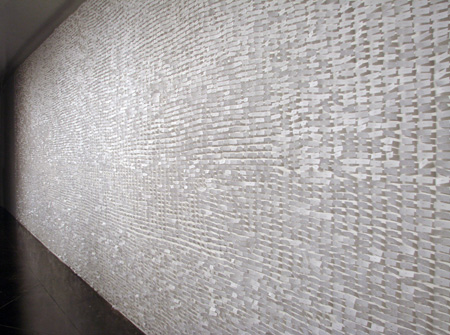
Continuing through February 25, 2012
When art places us squarely within the ambit of mystery, we’d be foolhardy to ask for more. Joseph Havel’s exhibition, “Plus or Minus” does precisely that. Like ambitious literary works, Havel’s art propels us into a realization that our lives — our phenomenological world — operate as an interlinear. We ferry about in a mysterium and this show reminds us that this lovely process is both gorgeous and enigmatic. Havel’s wall of repetitive men’s shirt labels, each bearing the word, “Nothing” adds up to a definite “something.” It gives us nothing less than a vector into how our minds operate. “Plus or Minus” ineluctably moves us to reflect upon the ways in which we interact with visual and written texts as well as the history we bring to bear upon them.
Havel’s work is elegant and thoughtful. So is the artist. He’s well read and highly articulate. He readily admits to having been seduced by the language of poet John Berryman — and the dreamy play between artist and writer and artist and viewer becomes a massively joyous occasion of parsing classic epistemological questions with spanking-new enthusiasm. The works here range from the aforementioned installation to bronze sculptures to minimalist oil and graphite on paper “articulations.” I choose not to call them paintings or drawings. Rather, they’re marvelous verbs held aloft and ready to be met with a gaze, a history, a stance or a simple emotion. In this case, “show” bears multiple meanings. It’s there for our delectation but, in the words of Shakespeare’s King Lear, it also teaches us “to see better.” And that’s impressive.
